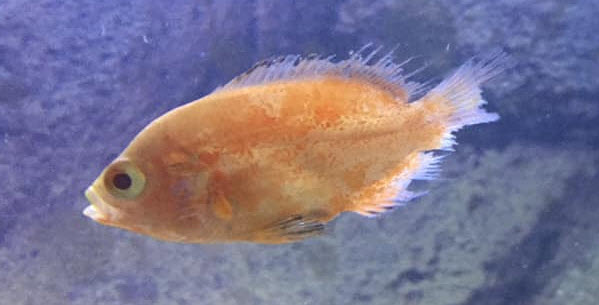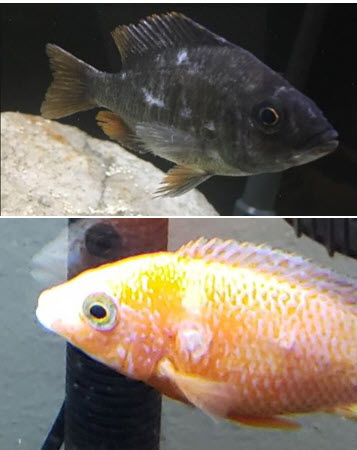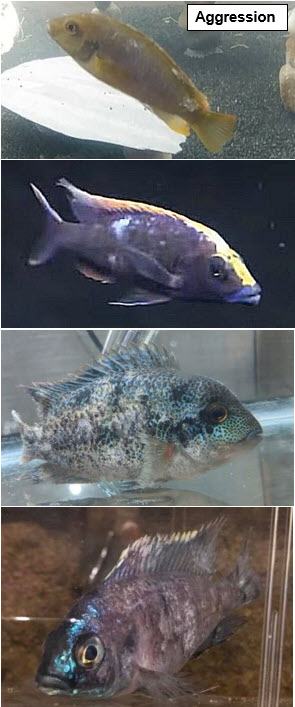
Aggression is a very common issue in fish aquariums, especially cichlid aquariums. Lake Malawi cichlids are very aggressive and some Central American cichlids are almost as bad.

Aggressive fish ram the less dominant fish, creating areas where the scales fall off. Fins get tattered and secondary bacterial infections set in. Fish which are the victims of aggression often die.
In the tank below a Red Empress Male has taken over a tank and has most of the other fish cowering on one side of the tank. This is typical and requires action on the part of the hobbyist.

The only solution to this problem I’ve found is removing one or the other of the fish to another aquarium. I’ve tried all sorts of aggression reducing things and none have worked very well. This is what aggression looks like:

There is another complication of aggression. Anytime a fish is the subject of bullying that fish’s immune system will suffer. And anytime a fish’s immune system goes down opportunistic pathogens can move in. These pathogens can include chilodonella, costia, epistylis and many bacteria. This can result in a very sick fish.

This fish needs a combined therapy isolated in a dark peaceful hospital aquarium. It needs an ich medication like copper or formalin/malachite green in the water and it needs a broad-spectrum antibiotic like Maracyn 2 ONLY IN THE FOOD.
Reducing Aggression
There are no hard and fast “rules” on aggression. I’ve had dominant auratus males (normally a downright vicious fish) that were decidedly mellow in a lightly stocked aquarium. I’ve had yellow labs (normally a pretty mellow fish) go on killing sprees in heavily stocked tanks. I’ve had giant bumblebee males (normally pretty nasty) that were “gentle giants” in the tank.
I’ve kept an Oscar that killed anything put in the tank with him, and I mean ANYTHING. I had another Oscar that lived for years with a feeder goldfish. Jewel cichlids are another very unpredictable fish, as are convicts and Parrots. This is why there is so much contradictory advice on how to reduce aggression and which fish are aggressive. When it comes to aggression and fish selection, I like the motto of “just do it”.
I’ve found the following possible ways to reduce aggression useful:
- Most important, do your research and for a given tank select species of fish which are the same aggression level (cichlid-forum.com/profiles).
- Understand that SOME Melanochromis, Nimbochromis and “predator haps” males are very aggressive. Some rightfully call SOME of these species’ “killers”, especially as FULLY-GROWN ADULTS (juveniles are typically mellow). Only stock them if you enjoy a challenge.

- Most mbuna and mixed tanks typically require heavy stocked (at least one 4” fish per two gallons and a minimum of 29 gallons and 15 fish) to reduce aggression (they also typically require heavy water changes and huge amounts of over-filtration). Note that a predator hap tank typically requires light stocking.
- Sex is important (Can’t believe I just said that, duh). For mbuna, I find I can mix sexes in heavily stocked tanks. In lightly or moderately stocked tanks I stock only male mbuna. For peacocks and haps, I only stock males.
- Avoid two male haps or peacocks of the same or similar species in the same tank.
- I don’t provide caves where fish can create territories.
- I always add new fish at least three at a time.
- I keep the lights off except when feeding or “admiring”
- Typically the cooler the water the less the aggression. Lake Malawi averages 75 and I keep my Malawi’s at 70 to 75.
But I need to emphasis:
.
ALL these points are only gross generalizations which only work some of the time.
.
.
Aquarium Science Website
The chapters shown below or on the right side in maroon lead to close to 400 articles on all aspects of keeping a freshwater aquarium. These articles have NO links to profit making sites and are thus unbiased in their recommendations, unlike all the for-profit sites you will find with Google. Bookmark and browse!
.

